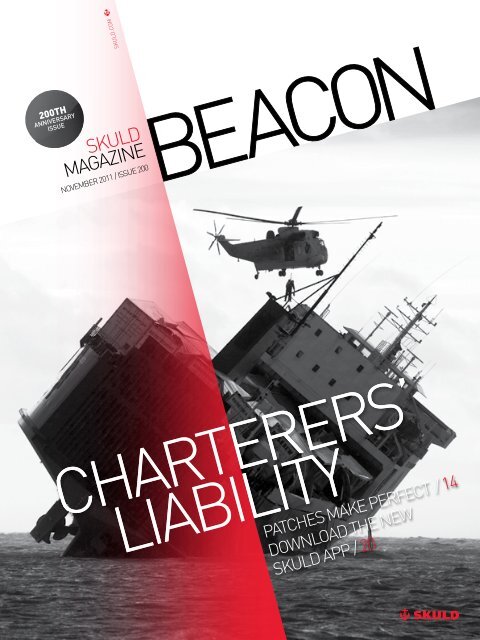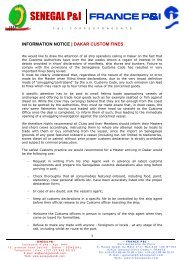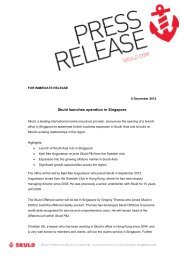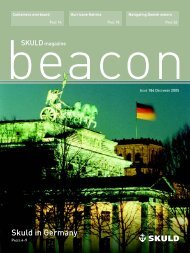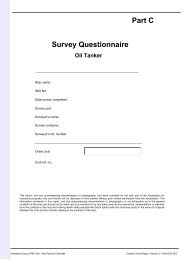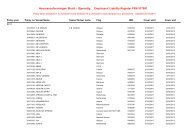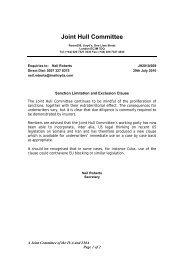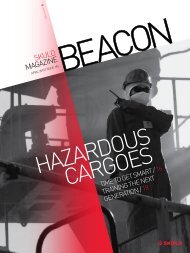Complete PDF version - Skuld
Complete PDF version - Skuld
Complete PDF version - Skuld
You also want an ePaper? Increase the reach of your titles
YUMPU automatically turns print PDFs into web optimized ePapers that Google loves.
contentsNEWS feature: Charterers’ liability6 2011 – the charterers’ year9 Grounding in the Orinoco River12 Extra bunker-handling costs now coveredLoss prevention14 Patches make perfect16 Passing inspectionCURRENT17 Going offshore in Aberdeen18 200 issues young20 Download the new <strong>Skuld</strong> appnews21 Personnel news23 News9Groundingin theOrinocoRiverA charterer member may ask – “what doesCharterer’s Liability to Hull (CLH) coverinclude and what is the benefit of havingit? As the article shows, charterers are atsignificant risk of substantial liabilitiesarising from relatively simple situations.20Downloadthe new<strong>Skuld</strong> appCorrespondent and vessel searchesworldwide have become quickerwith a brand new app. The app, togetherwith <strong>Skuld</strong>’s website and pdf access,are about to make the previously printedList of Correspondents redundant.
NEWS featureCharterers’ liabilityShining the spotlight on charterers’ liability2011 – the charIn 2011, <strong>Skuld</strong> has taken a strategic decision to increase focus on charterers’ liability. Egil GulbrandsenMandt, SVP Underwriting & Marketing, talks more about charterers’ cover with <strong>Skuld</strong>.<strong>Skuld</strong> was established in Oslo in 1897 and was the first P&I club outsidethe United Kingdom. “In the very early days, only shipowners could buycharterers’ cover. This quickly changed and <strong>Skuld</strong> was probably thefirst club to accept time and voyage charterers’ entries. We now offerP&I insurance to both time and voyage charterers and, from 2011,have opened up for one-year cover written anytime during the year,”says <strong>Skuld</strong>’s SVP in Underwriting & Marketing.Why charterers’ cover?A charterer is exposed to many of the same risks as a shipowner and,if transporting their own cargo, additional trading liabilities. Ascharterers appear in bills of lading, charterparties and/or othercontracts relating to the ship and voyage, they may enter into disputesand become legally liable. A charterer may be liable to the shipownerfor damage to or loss of the vessel, equipment and fittings, demurrage,loss of use or hire, including costs reasonably incurred. “A charterer isalways part of the General Average. The total bill is divided betweenthe shipowner, cargo owner and charterer,” says Egil.“We … haveopened upfor one-yearcover writtenanytimeduring theyear”access to individual accountsand enables charterers or theirbrokers to report new entries forcharterers’ liability cover directlyfrom their desks.“Online charterers’ declarationsare well received by current users.We are told that the system isuser-friendly and provides a goodoverview with constantly updatedlists and reports. <strong>Skuld</strong>’s onlinecharterers’ declaration systemsaves charterers’ and brokers’time and provides an easilyaccessible overview of a fleet’scoverage,” says Egil.Charter marketHistorically, the shipping industry is cyclical and subject to economicfluctuations. So far, it’s been a challenging year for global shippingand, correspondingly, <strong>Skuld</strong> has seen some reduction in chartereractivity. The largest markets for charter cover are Europe and Asia,specifically in China, Singapore, Thailand and India. There are over50,000 merchant ships trading internationally. Many charterers arestill without P&I insurance and choose to take the risk themselves.BrokersThe majority of <strong>Skuld</strong>’s charter business is transacted through brokers,some of whom specialise in selling charter insurance. “This year, wehave developed various marketing material and arranged severalevents to promote our charter cover. Brokers are important partnersfor <strong>Skuld</strong> and it is vital to maintain good relations with them”, says Egil.Online charterers’ declarationTraditionally, charterer declarations have been handled manuallythrough fax and email, often listing more details than needed orexcluding vital information. <strong>Skuld</strong> first introduced online chartererdeclarations in 2007 and is probably still the only P&I club offering thetool to brokers and charterers. This web-based facility provides direct<strong>Skuld</strong>’s online charterers’ declaration saves charterers’ and brokers’ time and providesan easily accessible overview of a fleet’s coverage,” says Egil Gulbrandsen Mandt,<strong>Skuld</strong>’s SVP in Underwriting & Marketing.6 beacon / NOVEMBER 2011
NEWS featureCharterers’ liabilityBy Marte Nordli AndersenExecutive, Marketing & Communication, <strong>Skuld</strong>marte.andersen@skuld.com/terers’ yearOver 50,000 merchant ships trade internationally. Many are still uninsured.<strong>Skuld</strong> is currently working on improving its online declaration tool,linking it directly with the club’s business systems and making it eveneasier to use.Simplified terms and extended coverPreviously, shipowners and charterers were covered by the samestatutes and rules. This year, <strong>Skuld</strong> has developed a bespoke set ofcharterers’ terms and conditions. This simplified framework facilitatesthe creation of extended and tailored cover for all chartering activities.“We have removed everything irrelevant for charterers. Feedback ispositive, simply because the terms are so easy to understand. In addition,charterers’ liability to hull (CLH) and extra bunker-handling costs arenow part of standard P&I cover under <strong>Skuld</strong>’s Charterer Terms &Conditions,” says Egil./The charterer market/ More than 50,000 merchant ships trade internationally/ Every ship has a charterer, some more than one/ Many charterers are still uninsured/ Some brokers specialise in charterers’ business<strong>Skuld</strong> entries/ All <strong>Skuld</strong> charterer entries are commercial business/ Owners’ business has never subsidised charterers’business/ <strong>Skuld</strong> offers a flexible and modern approachto charterers’ liability/ <strong>Skuld</strong> is the only P&I club offering online charterers’declarationsbeacon / NOVEMBER 20117
NEWS featureCharterers’ liability/Main differences in <strong>Skuld</strong> coverCharterersowners/ Commercial business Mutual business/ Limited cover ‘Unlimited’ cover/ Fixed price additional calls may occur/ Charterers’ liability No hull liabilityto hull included included/ Renew whenever Renew 20 February/Online charterers’ declaration<strong>Skuld</strong>’s Charterer Terms & Conditions means insurance is much easier to understandand adapt to individual needs.Charterers’ entries may be adapted through a vast variety of adjustableadditional covers that are tailored to meet the individual needs of eachmember. Examples are specific cover for cargo, property or extendedcontractual liability. In addition, <strong>Skuld</strong> also offers charterers’ defenceinsurance that provides valuable legal services by <strong>Skuld</strong>’s defenceteam. “Our defence team consists of professional lawyers representing16 jurisdictions. Our lawyers have extensive experience in handlingdisputes worldwide and operate in all time zones,” adds Egil.Charterers’ cover with <strong>Skuld</strong>“<strong>Skuld</strong> is one of the largest providers of liability covers for time andvoyage charterers. Traditionally, charterer and owner tonnage hasroughly been at the same level. Over the years, we have developedcomprehensive products for charterers, in terms of scope, depth ofsupport and specialist advice,” says Egil.Today, <strong>Skuld</strong>’s financial performance is strong. As of August 2011, theoutlook for <strong>Skuld</strong>’s A- rating was moved from stable to positive, reflecting<strong>Skuld</strong>’s strong underwriting track record. This position enables theclub to meet clients’ specific insurance and security demands.GET STARTED/ Identify yourself through the <strong>Skuld</strong> Extranet login withthe same password that you already use for claimsstatistics and reports, and start working. Your <strong>Skuld</strong>representative will gladly activate your account andassist if necessary.IT’S EASY!1. Search by IMO number or vessel name2. Select relevant cover3. Enter expected duration4. Press sendThis gives <strong>Skuld</strong> sufficient information to hold the vesselon cover and calculate the correct premium, which thenappears in the declaration overview.Go to <strong>Skuld</strong>.com, log on to Extranet and fill outsimplified charterers’ declarations online.Renowned service“Despite challenging global markets and several new parties enteringthe industry, <strong>Skuld</strong> is still a preferred provider of charterers’ cover.Charterer members should be aware that <strong>Skuld</strong> has a philosophy ofbeing close to members. We provide long experience and extensiveknowledge of the charterer trade. On the claims side, we offer proactiveassistance through experienced P&I claims handlers, legal expertiseand an extensive network of carefully selected correspondents”,concludes <strong>Skuld</strong>’s SVP in Underwriting & Marketing.For further information, please contact your <strong>Skuld</strong> syndicaterepresentative, email egil.mandt@skuld.com or call 22 00 22 72.read morewww.skuld.com/charterers8 beacon / NOVEMBER 2011
NEWS featureCharterers’ liabilityBy Christian OttAssistant Vice President, <strong>Skuld</strong> Far East Ltd.christian.ott@skuld.com/<strong>Skuld</strong>’s Charterer’s Liability to Hull coverGrounding in theOrinoco RiverA charterer member may ask – “what does Charterer’s Liability to Hull (CLH) cover include andwhat is the benefit of having it?” As the following true story demonstrates, charterers are atsignificant risk of substantial liabilities arising from relatively simple situations. <strong>Skuld</strong>’s coverprotects members against such liabilities and provides them with the benefit of the club’s pro-activeclaims-handling services.Case backgroundThe case arises from the grounding of a member’s chartered vessel inthe Orinoco River, Venezuela. The member time chartered the vesselfrom the disponent owner and then sub-voyage chartered her under acontract of affreightment with a BVI company. The sub-charterpartyhad been ostensibly guaranteed by a more substantial entity, althoughno effort was made to expressly confirm the guarantee in writing withthe guarantor. Both the head and sub-contract were on the basis ofexpress safe-berth and safe-port warranties.The vessel, a medium-sized Panamax bulk carrier, had part-loaded acargo of iron ore at Puerto Ordaz. She was traversing the Orinoco Riverto reach its mouth and load the balance of cargo. At this time she hadjust under 44,000 mt of iron ore on board, consigned to China.The Orinoco River, one of Venezuela’s main trade arteries, requiresregular dredging to keep it clear for commercial vessels. Shortlybefore the incident, the river was dredged, but marker buoys – whichdelineated the safe navigable channel – had not been returned to theirnormal positions. This made the channel appear visually wider than itreally was. The local harbour office posted warnings to this effect,which were given to the vessel and the pilot. However, the warningswere in Spanish and the master neither understood them or askedfor an explanation.The vessel navigated too close to the undredged part of the channel,possibly at too high a speed and ran aground. Fortunately, the crew,vessel and cargo were unharmed, although the vessel lay at right anglesto the channel blocking it completely. The result was a week-long operationto ‘dig’ the vessel out of the mud. Owners subsequently claimed forunsafe port and demanded over USD 2.5 million from the charterers.The Orinoco River, one of Venezuela’s main trade arteries, requires regular dredging tokeep it clear for commercial vessels.“Ownersclaimed forunsafe portand demandedover USD 2.5million ”<strong>Skuld</strong>’s responseUnlike the disponent owners andsub-charterers, <strong>Skuld</strong> initiated acasualty response to the incidentand mobilised the local correspondentand surveyor, as well asdispatching expert assistance tothe site. As a result of thisearly approach, <strong>Skuld</strong> securedcrucial evidence that significantlyimpacted the case in favour of theclub’s members.beacon / NOVEMBER 2011 9
NEWS featureCharterers’ liabilityThe Panamax bulk carrier was sailing theOrinoco River, one of Venezuela’s maintrade arteries.10 beacon / NOVEMBER 2011
NEWS featureCharterers’ liability//The Orinoco RiverPhoto: Kevin Schafer/CorbisOcean-going ships can sail 435 km up the Orinoco. Beyond that you may need a canoe./ One of the longest in SouthAmerica at 2,140 km (1,330 mi)/ Flows through Venezuelaand Colombia/ Together with its tributaries, itis the major transport systemfor Venezuela’s easternregion and interior/ In the rainy season, theOrinoco can swell to abreadth of 22 km (14 mi)and a depth of 100 m (330 ft)/ At its mouth, the river formsa wide delta of hundreds ofrivers and waterways thatflow through 41,000 km 2(16,000 sq. miles) ofswampy forests/ Navigable for most of itslength, dredging enablesocean-going ships to sail435 km (270 miles) upstreamSource: WikipediaLegal proceedings were pursued in chain arbitration, with rigorouspursuit of the sub-charterers despite their credit risk and doubts overthe guarantee’s enforceability. Litigation focused on getting the matterresolved before final adjudication as every party concerned faced asignificant litigation risk and subsequent costs.In particular, securing of witness statements and safe keeping of keydocuments, such as the harbour office notices and ship’s voyage data,were critical to the case’s success. With this information, <strong>Skuld</strong>’sexpert produced a computer-generated re-creation of the incident –something no other party had done – which gave a significant tacticalbenefit to <strong>Skuld</strong>’s members during negotiations with the owners.OutcomeAll sides, eventually, agreed to mediation. The process itself wasvery positive as three out of the four parties came to the table with aclear intention to settle. Unfortunately, one party ‘held out’ and noagreement was reached at the mediation. Negotiations followed, however,and six months later – before any hearing had taken place – the matterwas resolved through a settlement between all four parties.Compared to the initial claim, <strong>Skuld</strong>’s members successfully reducedtheir exposure significantly.Important additional lessonMembers relied on being ‘back to back’ because of the charterposition and the belief that a substantial company had guaranteed it.On closer examination, it was revealed that the guarantee was nomore than an uncorroborated ‘one line sentence’ in the fixture recapand probably not legally enforceable.The important lesson is that a bare-faced assertion of a guarantee in afixture recap should never be considered safe. At the very least, theguarantor must confirm expressly in writing that they commit to thepurported guarantee. Often it is necessary to ensure that the guaranteeconforms with the law of the charterparty, as well as with the law ofthe guarantor’s home jurisdiction.Finally, a guarantee is no stronger than the financial backbone of theperson or company giving it.“<strong>Skuld</strong>’s expert produceda computer-generatedre-creation ... somethingno other party had done”beacon / NOVEMBER 201111
NEWS featureCharterers’ liabilityImproved charterers’ liability insurancePhoto: 1-images.noCharterers no longer need CLH or FD&D cover when off-specification bunkers are supplied to the vessel. It’s now covered by <strong>Skuld</strong>’s charterers’ liability insurance.Extra bunker-handlingcosts now coveredAs of 20 February 2011, <strong>Skuld</strong>’s standard charterers’ cover includes extra costs and liability for extracosts incurred with the removal, storage, processing and disposal of bunkers supplied by thecharterers. The new rules represent a very significant improvement for charterers who no longerhave to rely on their CLH or FD&D covers where off-specification bunkers are stemmed to thechartered vessel.The charterer’s vessel, Calisto, was close to Cigading, Indonesia whenthe problems started. A fresh DNV report read like a horror story andstated that bunkers were contaminated. The master and crew roundedon the charterer, laying the blame squarely on their doorstep. Relationswere at an all-time low.The charterers’ operations manager called me. “I feel like I’ve just rolledout of bed and stepped into a pile of steaming hot dung!” he said.He demanded we appoint lawyers and start arbitration. “You will be farbetter off if you let the ownersand bunker suppliers handlethings between themselves. Atleast the suppliers have a realinterest in mitigating the loss andkeeping costs low”, I suggested.Fortunately, charterers had beensensible enough to obtain a clear12 beacon / NOVEMBER 2011
NEWS featureCharterers’ liabilityBy Kim SteffensenClaims Executive Lawyer, <strong>Skuld</strong> Copenhagenkim.steffensen@skuld.com/right of recourse against the bunker suppliers. Calls were made, thesuppliers became involved and the dispute was handled back-to-backfrom there. Furthermore, the charterers were able to benefit from thesupplier’s extensive knowledge.The operations manager called me again the next day: “We are goingbelly up!” he yelled. “The owners are deviating to Gladstone, Australiato take on board new bunkers. It will take an additional three days andthe time loss will cost us more than Liberia’s deficit”. “Get a grip ofyourself”, I replied. “You are fully covered under <strong>Skuld</strong>’s standardcharterers’ liability insurance for the loss of time and additionalcosts incurred”.Additional bunkers were stemmed at Gladstone and cargo loaded inTownsville and Darwin. The vessel then sailed for Fangcheng andQingdao. During the voyage to China, the phone rang constantly. “Mymood is foul tonight, so I will try to keep this short,” the operationsmanager said. “The owners are behaving like sharks in a savagefeeding frenzy!”Apparently, the owners had taken a unilateral decision to de-bunkerthe contaminated bunkers at Singapore and said that the loss of timecaused by the deviation and the de-bunkering costs should be paid bythe charterers. According to the owners, charterers were responsibleunder the charterparty for loading the contaminated bunkers on board.“The Ownersare behavinglike sharksin a savagefeedingfrenzy!”“Relax”, I said. “You are coveredfor that too under our charterers’cover. The new rule eight coversextra costs and liability for extracosts in connection with theremoval, storage, processing anddisposal of bunkers supplied forcharterers’ account. Naturally,this does not include the price ofthe substitution bunkers.”The operations manager calledvery early the following morning:“The owners are beating us like agong!” he said. “If I had theimagination I would have called insick today”. Raving and cursing,the owners had demanded thatthe tanks be cleaned afterde-bunkering. The cleaningoperation would delay the vesselanother day and cost SGD 20,000,let alone the cost of additionalbunker consumption while thevessel was in port.“The horrible reality of beingsuddenly stone broke and homelessis more than I can handle!”the operations manager said.“Calm down”, I replied. “We willcover you for that too under <strong>Skuld</strong>’sstandard charterer’s cover“.In short, the new rules improvethe charterer’s position in anumber of important ways. If thisincident had occurred before20 February 2011, chartererswould only have been covered forlegal costs under their FD&Dinsurance as there was nodamage to the vessel. The eventsabove took place at the end ofMarch 2011. Consequently,de-bunkering costs and deviationcosts are also covered.The owners claimed that charterers were responsible for loading the contaminated bunkers on board.read morewww.skuld.com/charterersbeacon / NOVEMBER 2011 13
LosspreventionSealing in your costsPATCHESMAKE PERFECTOil may be expensive when used for filling cars, but its price is nothing comparedwith the costs that materialise when it washes up on a beach. When this happens,it is usually underwriters who must pay the price.The most likely cause of oil pollution at sea is from vessels damaged bygrounding or collision. The sight of oil pouring from a torn bunker orstorage tank is something the world has witnessed too often and theinsurance industry is well aware of the massive price it carries.A very real cost that is rarely considered can arise after the incidentwhen the pressure inside the damaged bunker or cargo tanks is equalised.Although the initial outpouring has stopped, large volumes of hydrocarbonscan remain trapped within the vessel and become dischargedintermittently by wave action or through wreck movement. Wheneverthis happens, often years after, it can result in a new wave of claimsagainst the insurer.Although no two casualties are the same, the use of magnetic or flexiblepatches can often prevent more leakage and protect the insurer againstthe risk of further costs. Miko Marine AS of Oslo has seen its patchesdeployed with considerable effect on numerous occasions to minimisepollution and prevent total loss of the vessel.Miko is now well known for its range of flexible magnetic patches thathave saved the coasts of Scandinavia from pollution on several occasions.The most extreme example occurred late last year when the Danishflaggednuclear fuel carrier Puma began taking in water as it sailedsouth from Murmansk. It was a small leak caused by a defective valve,but the crew was unable to stop the inexorable flooding of its engineroom. Fortunately, as all Norwegian Coast Guard vessels are equippedwith Miko magnetic patches, it was a simple task to seal the leak andescort the Puma to Hammerfest for permanent repair. Had the patchnot been available, the ship might have been lost with frighteningconsequences for its underwriters.Although Miko patches are sometimes likened to a large, flexible fridgemagnet, magnetism is usually all that they have in common. It tookseveral years of careful research to develop patches capable of the tasksthey perform. First and foremost a patch must create a powerful bonddespite many layers of paint or corrosion that may sit between it and themetal. This is achieved by mixing rare-earth particles with an exceptionallyA holed Norwegian trawler is refloated with a Miko patch.“magneticor flexiblepatches canoftenpreventmoreleakage”strong blend of Nitrile rubber.With a stretch strength of 9000 Nper 5 cm it means that one fabricstrip is capable of lifting a car andis more than adequate for mostrepair applications. When the rareearthparticles are mechanicallyrolled together with the rubber,they become distributed in parallellines. Consequently, when theyare magnetised, they becomeintensely powerful, which led tofurther study to identify the mostsuitable rubber compound. Softrubber is more flexible andachieves a better seal, but canalso allow the powerful magneticparticles to realign themselvesand lose the benefit of being14 beacon / NOVEMBER 2011
LossPreventionBy Paul EastaughMiko Marine ASinfo@miko.no/arrayed in parallel lines. With thisobstacle overcome, a finishedpatch weighs ten kilograms persquare metre, necessitating anadditional layer of material toprovide buoyancy. With lifting lugsalso fixed to the patch duringmanufacture, it can be easilymanoeuvred into position underwater by divers. Once in place thepowerful magnetic bond can, ifdesired, be reinforced by additionalmagnets to create a dependablewatertight seal that enablesinterior compartments to bepumped dry or the dangers offurther oil leakage to be eliminated.When damage creates an unevensurface, it may not be possible toachieve an effective seal with Mikomagnetic patches alone. Underthese circumstances, the company’s‘hat-shaped’ patches can be usedwith equal effect. These aremanufactured from a high-strengthfabric that combines polyesterreinforced PVC with aramid. It isdescribed as ‘hat-shaped’ due toits design as a shallow bag with abrim that is held securely againstthe hull beneath flexible aluminiumstrips. These are quickly andsecurely fixed in position by diversusing an underwater stapling tool.The bag-like capacity of the patchenables it to cover any irregulartearing of the hull, while thestapled brim ensures a strongand watertight seal.Patches from Miko Marine were recently used to stop leakage from the Hurtigruten vessel Nordlys in Ålesund, Norway.“The trawlerm/v Nybo washoled in acollisionand left indanger ofsinking”‘hat-shaped’ patch had been delivered by Miko and fitted over thedamage so that the boat could sail to a repair yard. After some internalreinforcement repairs, the trawler was considered seaworthy andallowed to resume work. This was an important cash bonus for thefamily-owned boat, which was able to continue trawling in Arctic watersfor three weeks with the Miko patch in place before going to a dry dockfor permanent repair when the season closed.Although incidents such as these demonstrate the value of the patchescarried by the Norwegian Coast Guard, the need for their wider availabilitypersists. With slow, difficult and expensive underwater welding often theonly alternative, Miko magnetic and ‘hat-shaped’ patches are often theonly alternative to an expensive claim.Photo: ScanpixThe benefits of Miko patches weredemonstrated in the northernNorwegian fishing port of Vadsøwhen a substantial loss wasavoided after the trawler M/V Nybowas holed in a collision and left indanger of sinking. Two magneticpatches supplied by the NorwegianCoast Guard enabled the trawler’shold to be quickly pumped dry andmost of its valuable catch to besaved. Within six hours, a standardread morewww.miko.nobeacon / NOVEMBER 2011 15
LOSSPREVENTIONBy Niki MowinckelSenior Surveyor/Port State Control Co-ordinatorNiki.Mowinckel@dnv.comDNV introduces Port State Control Tool KitPassing inspectionDNV’s PSC Tool Kit helps vessels passport state controls.that provides guidance underthree PSC inspection scenarios.Photo: 1-images.noWhile DNV-classed vessels have led the industry for years with the lowestport state control detention figures, a rising number of detentions were seenin 2008. At the same time, DNV conducted a review of its port state controlcustomer support services.As a result, a unique tool to assist the vessel’s crew as well as onshoremanagement has been developed. No ship should be sailing unlessthe fire protection and essential safety equipment is in good shape andin full compliance with ISM regulations. This is where the Port StateControl Tool Kit comes in useful. It provides reminders about essentialsafety issues and guidelines for how to ensure quality.The new Port State Control Tool Kit includes a handy referencebooklet. The booklet covers information regarding port state controlinspections and updates on changes to MoU rules, in addition toremovable posters showing good and bad practice. The posters can behung in key locations to remind crew members about best-practicemaintenance routines for some high-risk inspection areas. It alsocontains a flowchart called ‘Master’s quick guide to PSC inspections’“It providesremindersaboutessentialsafetyissues ...”Using the DNV-designed softwareknown as PSC Wizard, shoresidestaff or onboard personnel cancustomise checklists with relevantreminders. Pictures of shipspecificsystems and equipmentcan be used as guidance whencarrying out regular maintenanceinspections. The software includesgeneric checklists for all mainPSC focus areas based on DNV’saccumulated experience withcommon problem areas. As userscan easily include their imagesand ship-specific information, thetool can be integrated into theirown maintenance programmesThe tool kit also helps prior todeparture with its special focuson components with highdeficiency rates.Since the launch in June 2009,close to 4,000 tool kits have beendistributed or purchased by DNVand non-DNV customers.According to DNV, regularupdates will be available to users.For more information,contact DNV’s PSC group atportstatecontrol@dnv.com.read morewww.dnv.com/psc16 beacon / NOVEMBER 2011
CURRENTBy Katinka Kure-DziakonskiClient Servicing and Marketing Assistant, <strong>Skuld</strong> OffshoreKatinka@skuld.com<strong>Skuld</strong> joins Offshore EuropeGoing offshore inAberdeen<strong>Skuld</strong>’s stand visualises the synergybetween traditional P&I, <strong>Skuld</strong> 1897’smarine and energy insurance and<strong>Skuld</strong> Offshore’s special liability coverfor vessels and units operating in theoffshore industry..Simon Smith, <strong>Skuld</strong> London (left) withGregory Thomas, <strong>Skuld</strong> Offshore.James Scott and Parisha Bansil of <strong>Skuld</strong> 1897./Offshore Europe 2011/ Location:Aberdeen, UK/ Dates:6 – 8 September/ Floor space:25,000 square metres/ Exhibitors:Over 1,500 from allfive continents/ Unique visitors:Approx. 32,000Background: Ann-Charlotte Zervens, Kevin Campbell and Christofer Kobro of <strong>Skuld</strong>.Foreground: Gregory Thomas, <strong>Skuld</strong> Offshore, talks with Claes Lindh, <strong>Skuld</strong>.Katinka Kure-Dziakonski, Claes Lindhand Ann-Charlotte Zervens of <strong>Skuld</strong>.The Offshore Europe conference and exhibition in Aberdeen is where a worldwide audience oftechnical specialists, engineers, industry leaders, insurance buyers and experts come together todiscuss all aspects of the upstream industry. This year’s conference theme was ‘Securing Safe,Smart, Sustainable Supply’ and all major oil and gas operating companies were present.In September, <strong>Skuld</strong> exhibited for the first time at Offshore Europewith representatives from <strong>Skuld</strong> P&I, <strong>Skuld</strong> Offshore and <strong>Skuld</strong> 1897sharing the same stand. Such a collective effort underlines thesuccessful synergy between the three entities and illustrates thecomplete insurance package <strong>Skuld</strong> now offers. The exhibition provideda great profiling and networking opportunity for <strong>Skuld</strong> and usefulcontacts were made.Offshore Europe 2011 broke previous attendance records with a totalcumulative attendance of 48,575. Offshore Europe alternates with OffshoreNorthern Seas in Stavanger, Norway. The next Offshore Europe will beheld during the week commencing 2 September 2013.read morewww.skuld.com/offshorebeacon / NOVEMBER 2011 17
CURRENT www.skuld.com/beaconLooking back on <strong>Skuld</strong>’s membership magazine200 issues youngYou’re now reading the 200th edition of <strong>Skuld</strong>’s membership magazine. The publication has beenaround in different forms and guises since October 1928, informing and educating its readershipabout P&I issues.A growing emphasis on loss prevention ledto the introduction of the newsletter, andloss prevention has featured prominentlyever since. The first issue challengesmasters and crew to consider how theycan help owners reduce premiums,including good advice on how to safelytransport timber, one of the most commonloads at the time. Another article advisesof a case where a vessel sailing toGothenburg hadn’t taken on enough bunkers– coal in this case – and needed to burnpart of its cargo to reach harbour.Editions have come regularly ever since,with a natural stop during and immediatelyafter the Second World War. Early issueswere black and white and in Norwegianonly. Illustrations were only used sparinglyfrom the very end of the 1950s and a regularcolour edition didn’t see the light of dayuntil 1976. The first dual-language editioncame in 1983 and it wasn’t until 1996 that<strong>Skuld</strong>’s membership magazine becameEnglish-language only. In fact, Beacononly became ‘Beacon’ in 1999 with its newname and redesign.In 2008, Beacon was redesigned again andis now available electronically. It may lookvery different from the 1920s, but as you turnthe pages, you can still feel the connectionwith the first issues all those years ago.October 1928 – <strong>Skuld</strong>’s membershipmagazine is launched.read more18 beacon / NOVEMBER 2011
CURRENT/It’s 1976 and the magazine is in glorious colourfor the first time.The first dual-language issue ispublished in 1983.The March 1993 issue tackles the Braercatastrophe.Norway’s King Harald visits <strong>Skuld</strong> on its100-year centenary in 1997.Beacon becomes ‘Beacon’ in 1999.The ‘new look’ Beacon, March 2009.beacon / NOVEMBER 2011 19
CurrentCORRESPONDENTS, ENTERED VESSELS AND EMERGENCY HOTLINEDownloadthe new <strong>Skuld</strong> appCorrespondent searches worldwide have become quicker with a brand new app. The app,together with <strong>Skuld</strong>’s website and pdf access, are about to make the previously printedList of Correspondents redundant.Additional access to <strong>Skuld</strong>-entered vessels and the club’s emergencyhotline makes it worthwhile downloading the free-of-charge app toyour smartphone.Correspondent searchCorrespondent searches through the app are performed in three ways:by name, by geographic area and through smartphone location servicesfor nearby correspondents. Searches list all correspondent details, suchas name, address, website and map reference. Favourites may be addedby pressing the star at the top right of the display.<strong>Skuld</strong>’s List of Correspondents will no longer be printed and distributed.The complete and continually-updated list is only available through the<strong>Skuld</strong> app and <strong>Skuld</strong>’s website database www.skuld.com/correspondents.Website access also includes a monthly-updated pdf <strong>version</strong>.Vessel searchAn app search gives detailed information for <strong>Skuld</strong> P&I-entered vessels.Facts provided are vessel name, <strong>Skuld</strong> member and registered owner,flag state, gross tons, IMO number, year built, vessel type, blue cardsand the <strong>Skuld</strong> syndicate where the vessel is listed.Emergency 24/7 hotlineThe <strong>Skuld</strong> app allows you to automatically dial <strong>Skuld</strong>’s emergencytelephone number. This gives immediate access to <strong>Skuld</strong> personnel atall times of the day or night./DOWNLOAD THE SKULD APP/ For Android users:Through Android Market,search for ‘<strong>Skuld</strong>’./ For iPhone users:Through App Store,search for ‘<strong>Skuld</strong>’.AndroidiPhoneJust scan the QR code and download thenew app to your smartphone.The free-to-download <strong>Skuld</strong> app makes finding vessels and correspondents much easier.20 beacon / NOVEMBER 2011
newsOTHER SKULD NEWSLIFEBOATRELEASEHOOKSClass of 2011: School’s out – this time at Vigeland Park, Oslo. A sight-seeing tour of thecity is part of <strong>Skuld</strong> School’s social side.<strong>Skuld</strong> School comesof ageThe 18th consecutive <strong>Skuld</strong> School has just been held in Oslo withparticipants from 24 countries. From its humble beginnings in 1994,the intake has grown ten-fold to a regular group of 100 students.Lectures and seminars have been taken out of house and are conductedin city-centre conference facilities by <strong>Skuld</strong> staff. The course is runover three days and gives a thorough introduction into P&I and how theassociation operates. Upon ‘graduation’, students receive theirCertificate in P&I Insurance.It’s not all work. Social events have become increasingly appreciatedby both delegates and <strong>Skuld</strong> staff, and are seen as an opportunity tonetwork and create new contacts. It could even be said that <strong>Skuld</strong>School’s popularity has taken us by surprise. In just a few days of emailinvitations being sent to members, brokers and other industry contacts,the course fills to capacity. Naturally we are delighted at the responseand can’t wait to welcome the class of 2012!Lifeboat Release Hooks is a guide to help develop loss prevention programmes andmaintenance manuals.Latest <strong>Skuld</strong> publicationLifeboat Release HooksThe booklet, Lifeboat Release Hooks, covers the important subject oflifeboat-related accidents.As seafarers often serve on different ships, they may be unfamiliarwith a vessel’s lifeboats. Consequently, accidents are frequentlycaused by poor understanding of lifeboat operations, particularly therelease gear systems, and shortfalls in repair and maintenance. Inresponse to these issues, <strong>Skuld</strong> has published Lifeboat Release Hooksin co-operation with Witherby Seamanship International. The aim is tohelp members prevent future lifeboat-related accidents. It is meant asa guide to help develop loss prevention programmes and maintenancemanuals.All <strong>Skuld</strong> members have received a copy of the booklet freeof charge. Further copies may be ordered directly fromwww.witherbyseamanship.com. By entering the promotionalcode SKULDSPEC, members receive 20% discount on theretail price of USD 32.read morewww.skuld.com/Publications/Lifeboats-Release-Hooksbeacon / NOVEMBER 2011 23
marcH 20 1 / i sue 1 9skuld.com<strong>Skuld</strong>magazinenext issueout MARCH 2012The humanELEMENTTo err is human. The trick is to learn andmove forward. In the next edition, we’ll lookat the lessons to be learnt from crew errorand the issue of personal injury at sea.about skuldAs the New Generation P&I Club,<strong>Skuld</strong> provides liability insuranceto new generation shipowners andclients in the shipping industry.The head office for global operationsis located in Oslo, with additionaloffices in Aberdeen, Bergen,Copenhagen, Hamburg, Hong Kong,London, Moscow, New York andPiraeus.24-houremergencynumber+47 952 92 200Call this number if you havean emergency where <strong>Skuld</strong>can assist.beacon back issuesFor back issues of Beacon, please go to the publicationssection of our website. You can print an entire issue oruse the table of contents to select individual articles.skuld.comskuldmagazineskulddeFenceFailing inspection / 16citadels and armedguards / 23Earlier editionswww.skuld.com/BeaconRUSELØKKVEIEN 26NO-0251 OSLOP.O. BOX 1376 VIKANO-0114 OSLONORWAYTEL +47 22 00 22 00FAX +47 22 42 42 22skuld.com


